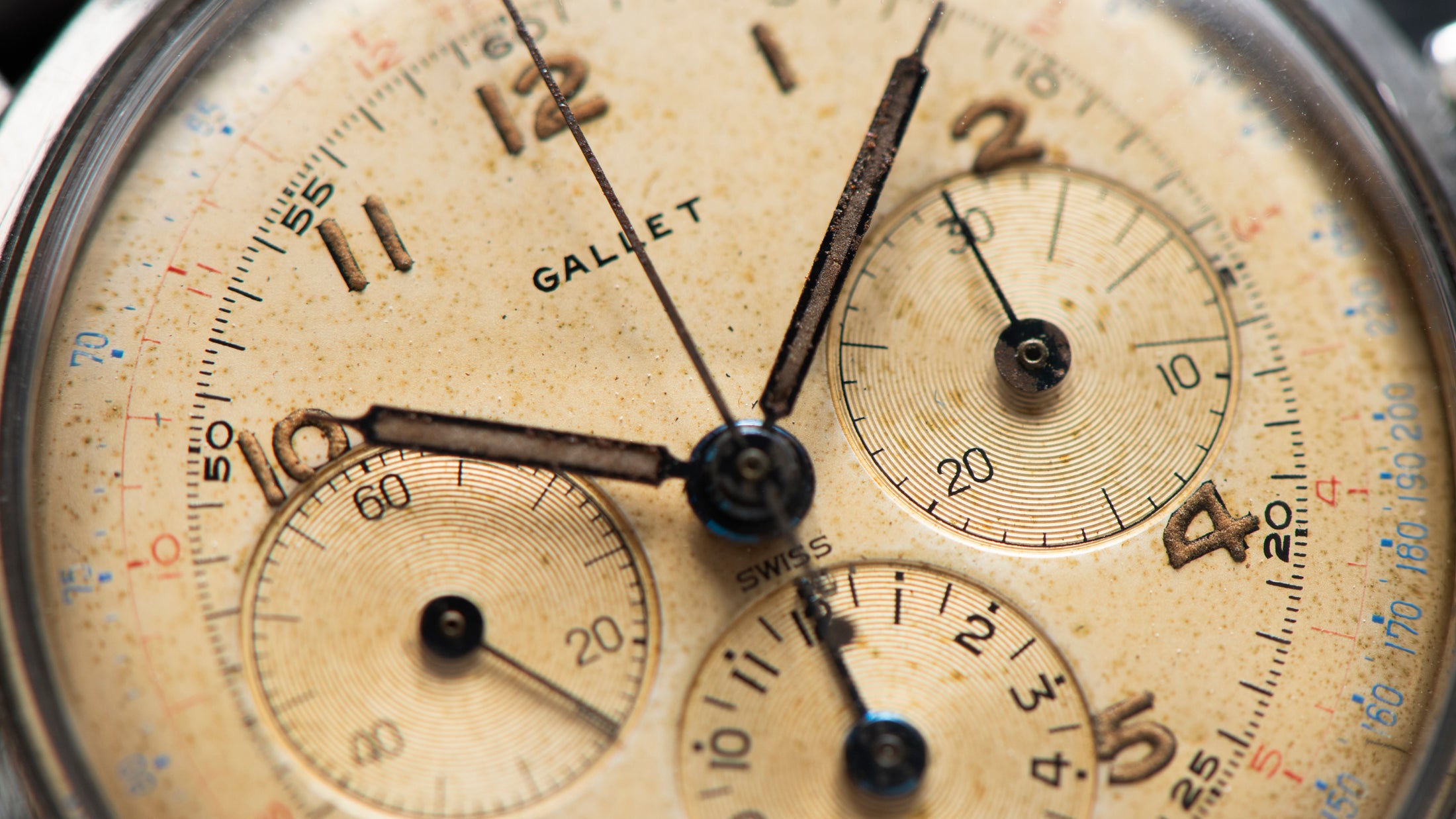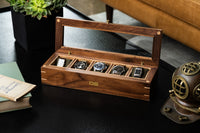You surely see and hear us bandy the term about with some frequency here at Analog:Shift. And to be fair, it’s not just us — the word seems to be on the lips of every vintage-obsessed watch collector these days. But what exactly do we mean by “patina,” and why is it so desirable?
“Patina,” as defined by Merriam-Webster, has several definitions, the two most pertinent being: “A usually green film formed naturally on copper and bronze by long exposure or artificially (as by acids) and often valued aesthetically for its color,” and, “A surface appearance of something grown beautiful especially with age or use.” As relatively few watches are made of bronze, we can surmise that by “patina,” we’re typically referencing the latter definition.

Omega Speedmaster Ref. 105.002-62 - IN THE SHOP
Take, for example, an old Speedmaster from the 1960s, whose dial was manufactured using tritium luminous material. As this material ages, it degrades — its half-life is just 12.33 years — and often changes color, perhaps from bright yellow to a dull, sand-like hue. Additionally, old paints used on watch dials in the 20th century were often relatively unstable, and changed color in the sun, or when exposed to moisture. So imagine, if you will, that this once-black Speedmaster is now brown.

Rolex Explore Ref.1016 "Tropical" - (Image by Hairspring)
These features, you may have noticed — this patina — are technically defects: The dial was made black, with yellow luminous material. It wasn’t meant to fade to brown with sand-colored lume. But often, people are attracted to just such “defects” imparted with age and use, which rendered aged products more desirable in the eyes of collectors. With the rise of online watch publications such as HODINKEE in the late 2000s, interest in vintage watches exploded, and with it, interest in patina. These days, you’re perfectly liable to see a young man walking the streets of SoHo in a “tropical”-dial Rolex Explorer Reference 1016 — a watch that might have been produced 35 years before he was born.
Auction prices have grown to reflect an interest in patina, with said “tropical”-dial watches (whose original black color has turned brown”) attracting serious premiums in recent years. Furthermore, terms such as “honest” — as in, a watch’s “honest” condition, meaning that it hasn’t been overly babied, polished, or upgraded — are finding their way into the vernacular. Of course, there’s a fine line between a “patinated” watch and one that’s just plain beat up, and collectors need to be aware of this so as not to be taken advantage of by an unscrupulous dealer.

Patek Philippe. A stainless-steel wristwatch with ‘tropical’ dial and bracelet - (Image by Christie's)
Patina, of course, isn’t relegated only to a watch’s dial — though this is perhaps where it is most readily appreciated: A old steel bracelet’s scratches and bangs and are its own form of patina, and the parched, perhaps musty-smelling boxes and papers that accompany a “full-set” example of a rare vintage reference are likewise imbued with this character. As with all things, patina is an acquired taste; some collectors simply don’t like the look of faded lume, unclear printing, or scratched bracelets, and this is perfectly well and good.
Here at Analog:Shift, we built an entire business around patina, sourcing vintage watches from throughout the 20th century and offering them to you, dear collector, with as much of their history and character intact as possible. We firmly believe that the imperfections — the wabi-sabi, if you will — inherent in patina are what give vintage and pre-owned watches much (if not most) of their charm.
Don’t believe us? We invite you to swing by our New York City headquarters to check out a few of the vintage pieces we have on offer. We’re sure that once you do, you’ll understand that the imperfections imparted upon a watch by the passing decades are their own form of magic — and the very basis of this entire hobby.
Good hunting!
Some Excellent Watches with Patina
LIP Nautic Super Compressor ($1,850)

LIP Nautic Suoer Compressor - IN THE SHOP
This 36mm Super Compressor-cased diver from French firm LIP is a beautiful example of a vintage 1960s diver — but it’s made all the better for its excellent patina: The tritium luminous material on the dial has faded to a beautiful sandy color within the numerals and hands. Contrasting against the gloss black of the dial with its white printing, this makes for a beautiful aesthetic that vintage watch collectors absolutely love.
Heuer Monte Carlo Dash Timer for Abercrombie & Fitch ($4,000)

Heuer Monte Carlo Dash Timer for Abercrombie & Fitch - IN THE SHOP
This incredible, double-signed dash timer — produced by Heuer and retailed by Abercrombie & Fitch in the 1960s — is chock full of fabulous patina: a rich orange on the dial where the luminous material has aged uniformly, plus the aged quality of the paper/cardboard found in its original box and instruction manual. A vestige of a much more analog era, it’s a clear reminder that newer is most certainly not always better.
Angelus Chronodato Triple Calendar Chronograph ($5,900)

Angelus Chronodato Triple Calendar Chronograph - IN THE SHOP
In this Chronodato from the 1940s, the watch’s grey dial has taken on a fantastic, speckled patina likely resulting from the brass dial black showing through the paint. Though technically a defect, its uniformity through the dial makes for a terrific, unexpected design — this, complemented with the aged numerals and beautiful, gleaming steel handset, turns an “old” watch into a thing of beauty.
Cornavin 'Decompression Dial' Dive Watch ($7,200)

Cornavin 'Decompression Dial' Dive Watch - IN THE SHOP
Here, we see yet another example of luminescent material having turned from white/yellow to a deep brown color: Take a look at the quadrant indices and the central minutes hand of this unique diver from Cornavin, and you’ll notice immediately the effect it imparts, mixing tastefully (though unintentionally, perhaps) with the black background and white printing. The central hour disc, too, has taken on a parchment-like patina, giving this ‘60s-era tool watch some extra “cool” factor.
Audemars Piguet Royal Oak 'Tropical' ($36,650)

Audemars Piguet Royal Oak 'Tropical' - IN THE SHOP
A “tropical” dial results when paint, originally black, deteriorates over time due to UV exposure, humidity, or other conditions, causing the paint to turn brown. If this happens uniformly, the results are highly prized by collectors — as on this Royal Oak from the 1970s, which has turned a pleasing copper color. Because this reference was never offered in such a color originally, the patination process naturally creates a unique example. Pretty neat, eh?













